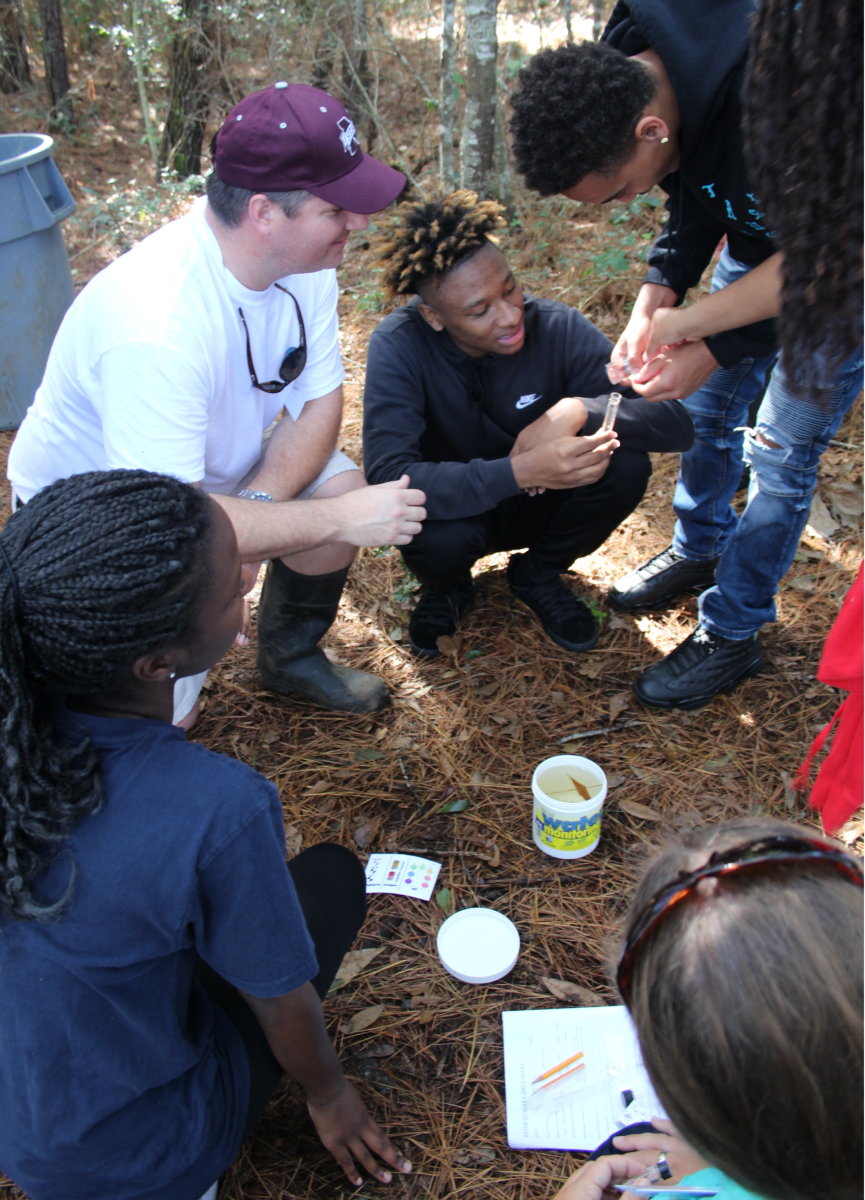MSU and St Martin High School Partner to Improve Water Quality in Old Fort Bayou
December 1, 2018

ST MARTIN, MS (November 16, 2018)
Over the last month around 80 upperclassman students in the Marine Science classes and Biophila Club at St. Martin High School have been learning about Old Fort Bayou Watershed and gathering data on water quality in the bayou and factors that may be impacting water quality. The student teams are now compiling their findings in the form of storyboards that include their vision for the future of the watershed and recommendations. The work will be included in the Watershed Implementation Plan for Old Fort Bayou that is being developed concurrently with funding through a U.S. Environmental Protection Agency (EPA) FY2015 Nonpoint Sources Grant awarded by the Department of Environmental Quality (DEQ) to the Land Trust for the Mississippi Coastal Plain that will lead to recommended policy and restoration actions for the watershed.
As the lead on the project, Mississippi State University's Gulf Coast Community Design Studio was awarded funding to work with the students through the National Oceanic and Atmospheric Administration's (NOAA) Gulf of Mexico Bay Watershed Education and Training (B-WET) Program. The program, which began in October, challenges students to learn about watershed dynamics in Old Fort Bayou Watershed and the impacts of stormwater runoff on water quality and quantity, alongside NOAA staff and other science professionals. The Old Fort Bayou Watershed consists of just over 32,000 acres in Ocean Springs, Gautier and Jackson County, Mississippi. The bayou is a tributary of the Back Bay of Biloxi and has been identified as a priority watershed by the Mississippi Department of Environmental Quality that may be a source of pollutants impacting water quality in the Back Bay and Mississippi Sound. The main sources of pollutants are likely coming from a range of nonpoint sources including expanding development close to the waterway and livestock operations on rural estates in the upper watershed.
St. Martin High School is adjacent to Old Fort Bayou and was an ideal setting to start engaging students and the larger community around stormwater and water quality issues and opportunities for improvement in the watershed. In addition to doing assessments of their school property, the students did water quality testing and learned about best management practices at two additional sites along the Bayou: The Twelve Oaks Property and Nature Trail in Ocean Springs that is owned and managed by the Mississippi Department of Marine Resources and Secretary of State Coastal Preserves Program and the Land Trust for the Mississippi Coastal Plain and The Preserve Golf Club in Vancleave. The Preserve Golf Club is a certified Audubon Signature Sanctuary dedicated to protecting the natural environment in addition to providing a high-quality golf experience. We're proud of what we do here at The Preserve and it was great to be able to share some of the Low Impact Development strategies we use on the golf course to protect the environment and water quality in Old Fort Bayou, said Stephen Miles, Director of Golf Operations at Old Fort Bayou. Golf courses can have a significant impact on water quality and it is important to show that the steps we have taken here at The Preserve to protect water quality have not only been good for the environment, but good for business.
During the field experience students worked alongside professionals and volunteers from local nonprofits, various state and federal agencies including the Land Trust for the Mississippi Coastal Plain (LTMCP), NOAA National Centers for Environmental Information Center for Coast, Oceans and Geophysics (NCEI), EPA Gulf of Mexico Program, National Park Service, Mississippi Department of Wildlife, Fisheries and Parks, and The Nature Conservancy.
"We are excited to partner on this project and happy when we can help students learn about and experience nature in unique ways", commented Judy Steckler, Executive Director of the Land Trust for the Mississippi Coastal Plan. We are also looking forward to including the students work in the Watershed Plan for Old Fort Bayou that we are developing in partnership with the Gulf Coast Community Design Studio and Mississippi Department of Environmental Quality. The Watershed Implementation Plan will be completed in December and student work will be on display for the Advisory Committee at their final meeting on December 17
th. The meeting will be held during school hours so students who participated in the project can interact with members of the Advisory Committee. Additionally, students will have the opportunity to apply for a paid summer internship working with the Gulf Coast Community Design Studio, LTMCP and the Jackson County Planning Department to start implementing the plan.
"This has been a great way for our students to get involved in an important project in their community and see how what they learn in the classroom really does have relevance", said Mike Heise, a science teacher at St. Martin High School. "The students have also enjoyed interacting with professionals and learning about professions related to environmental science and planning".
To learn more about Mississippi State University's Gulf Coast Community Design Studio, visit:
http://gccds.org.
To learn more about NOAA and the B-WET program, visit:
http://www.noaa.gov/office-education/bwet.
To learn more about the Land Trust for the Mississippi Coastal Plain, visit:
http://ltmcp.org/.
 ST MARTIN, MS (November 16, 2018)
ST MARTIN, MS (November 16, 2018)